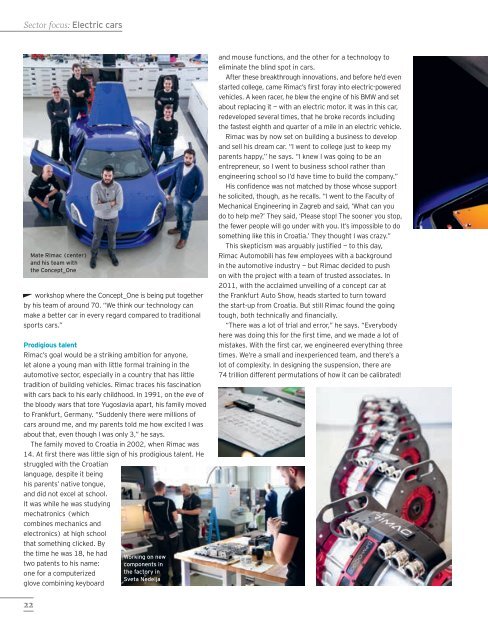Exceptional
Ua1bc
Ua1bc
Create successful ePaper yourself
Turn your PDF publications into a flip-book with our unique Google optimized e-Paper software.
Sector focus: Electric cars<br />
Mate Rimac (center)<br />
and his team with<br />
the Concept_One<br />
workshop where the Concept_One is being put together<br />
by his team of around 70. “We think our technology can<br />
make a better car in every regard compared to traditional<br />
sports cars.”<br />
Prodigious talent<br />
Rimac’s goal would be a striking ambition for anyone,<br />
let alone a young man with little formal training in the<br />
automotive sector, especially in a country that has little<br />
tradition of building vehicles. Rimac traces his fascination<br />
with cars back to his early childhood. In 1991, on the eve of<br />
the bloody wars that tore Yugoslavia apart, his family moved<br />
to Frankfurt, Germany. “Suddenly there were millions of<br />
cars around me, and my parents told me how excited I was<br />
about that, even though I was only 3,” he says.<br />
The family moved to Croatia in 2002, when Rimac was<br />
14. At first there was little sign of his prodigious talent. He<br />
struggled with the Croatian<br />
language, despite it being<br />
his parents’ native tongue,<br />
and did not excel at school.<br />
It was while he was studying<br />
mechatronics (which<br />
combines mechanics and<br />
electronics) at high school<br />
that something clicked. By<br />
the time he was 18, he had<br />
two patents to his name:<br />
one for a computerized<br />
glove combining keyboard<br />
Working on new<br />
components in<br />
the factory in<br />
Sveta Nedelja<br />
and mouse functions, and the other for a technology to<br />
eliminate the blind spot in cars.<br />
After these breakthrough innovations, and before he’d even<br />
started college, came Rimac’s first foray into electric-powered<br />
vehicles. A keen racer, he blew the engine of his BMW and set<br />
about replacing it — with an electric motor. It was in this car,<br />
redeveloped several times, that he broke records including<br />
the fastest eighth and quarter of a mile in an electric vehicle.<br />
Rimac was by now set on building a business to develop<br />
and sell his dream car. “I went to college just to keep my<br />
parents happy,” he says. “I knew I was going to be an<br />
entrepreneur, so I went to business school rather than<br />
engineering school so I’d have time to build the company.”<br />
His confidence was not matched by those whose support<br />
he solicited, though, as he recalls. “I went to the Faculty of<br />
Mechanical Engineering in Zagreb and said, ‘What can you<br />
do to help me?’ They said, ‘Please stop! The sooner you stop,<br />
the fewer people will go under with you. It’s impossible to do<br />
something like this in Croatia.’ They thought I was crazy.”<br />
This skepticism was arguably justified — to this day,<br />
Rimac Automobili has few employees with a background<br />
in the automotive industry — but Rimac decided to push<br />
on with the project with a team of trusted associates. In<br />
2011, with the acclaimed unveiling of a concept car at<br />
the Frankfurt Auto Show, heads started to turn toward<br />
the start-up from Croatia. But still Rimac found the going<br />
tough, both technically and financially.<br />
“There was a lot of trial and error,” he says. “Everybody<br />
here was doing this for the first time, and we made a lot of<br />
mistakes. With the first car, we engineered everything three<br />
times. We’re a small and inexperienced team, and there’s a<br />
lot of complexity. In designing the suspension, there are<br />
74 trillion different permutations of how it can be calibrated!<br />
22









